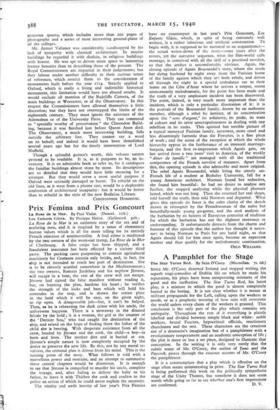The City of Oxford
THOUGH Oxford lays its obvious architectural splendours at the feet of the most casual visitor, there are other and enor- mous riches tucked away in senior common rooms and wardens' lodgings and even in the obscure sanctuaries of the individual scholar. It is indeed one of the delights of the place that it is no orderly museum of classified exhibits. Its beauties must be sought out and hunted down. One must cultivate the Master of X or seek invitation to the high table at Y in order to gain access to some of the finest interiors of all. After a lifetime of residence in Oxford one might still meet with fresh and surprising rewards.
Hitherto there has been no nearer approach to a full account than Aymer Vallance's Colleges of Oxford. That was a magnificent work; but it is superseded by the latest produc- tion of the Royal Commission on Historical Monuments. The authority of the Commissioners has enabled them to carry through a more thorough research than any private topo- grapher. Their survey has included private houses, tavern- vaults, back premises and slums They have produced a
generous quarto, which includes more than 200 pages of photographs and a series of most interesting ground-plans of all the colleges.
Mr. Aymer Valiance was considerably handicapped by his lack of sympathy with classical architecture. In secular buildings he regarded it with disdain, in religious buildings with horror. He was apt to devote more space to lamenting former beauties than to describing those of the present. The Royal Commissioners are impartial in their judgements; but they labour under another difficulty in their curious terms of reference, which restrict them to the consideration of monuments built before the year 1714. Strictly applied to Oxford, which is really a living and indivisible historical monument, this limitation would have too absurd results. It would exclude all mention of the Radcliffe Camera, of the main buildings at Worcester, or of the Observatory. In this respect the Commissioners have allowed themselves a little discretion; but they have not overstepped the limits of the eighteenth century. They must ignore the existence of the Ashmolean or of the University Press. They can commend as " specially worthy of preservation" the Clarendon Build- ing, because it was finished just before Queen Anne died. The Observatory, a much more interesting building, falls outside the arbitrary line. They cannot say a word on its behalf; and indeed it would have been demolished several years ago but for the timely intervention of Lord Nuffield.
Though a splendid guinea's worth, this volume cannot pretend to be readable. It is, as it purports to be, an in- ventory. It is an admirable book to refer to, for it catalogues the familiar buildings almost stone by stone. Its descriptions are so detailed that they would have little meaning for a stranger. But they would serve a most useful purpose if Oxford were seriously damaged or burnt. To rebuild on the old lines, as it were from a plaster cast, would be a deplorable confession of architectural incapacity: but it would be better than to rebuild in the style of the new Bodleian Library.
CHRISTOPHER HOBHOUSE.























































 Previous page
Previous page